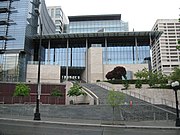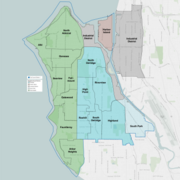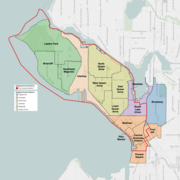Seattle City Council
Seattle City Council | |
|---|---|
| City Council | |
 | |
 Map of the seven districts effective January 2016 Map of the seven districts effective January 2016 | |
| Type | |
| Type | |
| Leadership | |
President of the Council | |
| Structure | |
| Seats | 9 |
 | |
Political groups |
|
| Committees | List
|
| Elections | |
| Electoral districts with four-year terms | |
Last election | November 3, 2015 |
| Meeting place | |
 | |
| Seattle City Hall 600 Fourth Avenue, Second floor Seattle, Washington 98104 | |
| Website | |
| http://www.seattle.gov/council/ | |
The Seattle City Council is the legislative body of the city of Seattle, Washington. The Council consists of nine members serving four-year terms, seven of which are elected by electoral districts and two of which are elected in citywide at-large positions; all elections are non-partisan. It has the sole responsibility of approving the city's budget, and also develops laws and policies intended to promote the health and safety of Seattle’s residents. The Council passes all legislation related to the City’s police, fire, parks, libraries, and electric, water, solid waste, and drainage utilities.
Elections
Election of city council members occur on odd-numbered years, with either four or five councilmembers up for election based on position number. All council members' terms begin January 1. The council positions are officially non-partisan, and the ballot gives no party designations. Party identification is based on candidates' voluntary self-identification.
| District | Member | Party | First elected |
|---|---|---|---|
| 1 | Lisa Herbold | Democratic | 2015 |
| 2 | Bruce Harrell, Council President | Democratic | 2007 |
| 3 | Kshama Sawant | Socialist Alternative | 2013 |
| 4 | Rob Johnson | Democratic | 2015 |
| 5 | Debora Juarez | Democratic | 2015 |
| 6 | Mike O'Brien | Democratic | 2009 |
| 7 | Sally Bagshaw | Democratic | 2009 |
| 8 (at-large) | Tim Burgess, Council President | Democratic | 2007 |
| 9 (at-large) | Lorena González | Democratic | 2015 |
Districts

In 2013, a voter-initiative was passed calling for the nine citywide-elected Seattle City Council seats to be divided into seven neighborhood district elected positions and two citywide, at-large seats.[2] The first primary based on this system was held, August 4, 2015 and the first city council election based on districts was held on November 3, 2015.[3]
The approximate neighborhood and city-wide positions are as follows. Some neighborhoods overlap more than one district, indicated with an asterisk*.[4]
| Position | District | Neighborhoods |
|---|---|---|
| 1 | 1 | West Seattle, Delridge, South Park, Harbor Island, Industrial District* |
| 2 | 2 | Beacon Hill*, Central District*, Downtown*, Rainier Valley*, Georgetown, Seward Park, Industrial District* |
| 3 | 3 | Beacon Hill*, Capitol Hill*, Cascade*, Central District*, Rainier Valley* |
| 4 | 4 | Bryant, Cascade*, Fremont, Laurelhurst, Ravenna, Roosevelt, Sand Point, University District, View Ridge, Wallingford*, Wedgwood* |
| 5 | 5 | Bitter Lake, Broadview, Greenwood*, Lake City, North Beach/Blue Ridge*, Northgate, Roosevelt*, View Ridge, Wedgwood* |
| 6 | 6 | Ballard, Crown Hill, Fremont*, Green Lake*, Greenwood*, North Beach/Blue Ridge*, Phinney Ridge, Wallingford* |
| 7 | 7 | Capitol Hill*, Cascade*, Downtown*, Interbay, Magnolia, South Lake Union, Queen Anne |
| 8 | At-large position, citywide | |
| 9 | At-large position, citywide | |
-
District 1
-
District 2
-
District 3
-
District 4
-
District 5
-
District 6
-
District 7
History
Seattle was first incorporated as a town by an act of the Territorial Legislature on January 14, 1865. The act was repealed January 18, 1867, after most of the town's leading citizens petitioned for its dissolution. During its first tenure as an incorporated entity, Seattle was governed by a Board of Trustees. Seattle was again incorporated, this time as a City, on December 2, 1869.
The Seattle City Council has taken several forms over the years. During the years of the Washington Territory, Seattle was incorporated by the Territorial Legislature as a town from January 14, 1865 until January 18, 1867 when the legislation was repealed based on a citizens' petition. During this time, Seattle was governed by a Board of Trustees. Seattle was re-incorporated as a city on December 2, 1869. Its original unicameral legislature, known as the Common Council, was elected at-large. At-large election was replaced in 1884 by a system of 14 wards and four members elected at-large.
According to the Seattle City Clerk's website, "In 2013, Seattle voters passed a measure amending our city's charter to establish City Council districts. In 2015, voters elected seven out of the nine City Council members by district. The remaining two positions will be elected "at-large" (city-wide) in positions 8 and 9."[5]
Timeline
- 1869–1883 – Seven at-large Council members elected for one-year terms.
- 1884 – Nine Council members elected: three from each of the three wards, elected to two-year terms.
- 1886 – One ward added, Council reduced to eight members: two elected from each ward for two-years terms.
- 1890 – The Home Rule Charter established eight wards and bicameral legislature. A Board of Delegates composed of nine at-large members was elected for four-year terms. House of Delegates had 16 members – Two from each ward, elected for two-year terms.
- 1892 – One ward added to make nine. Both houses to have nine members – all elected from wards.
- 1896 – New Home Rule Charter reestablished unicameral legislature with nine wards. One Council member elected from each ward for two years and four elected at large for four-year terms.
- 1905 – Two wards added to make 11. One Council member from each with four at-large – 15 council members total.
- 1907 – The Charter was amended twice during the year, the first time adding two more wards, increasing the size of Council to 17. Later, another ward was added (to make 14), increasing Council to 18 members.
- 1910 – The Charter was amended to abolish wards, reduce Council to nine at-large positions elected to three-year terms. This took effect in 1911 and remained constant until 1946. The 1910 Charter amendments also made the elections non-partisan. Prior to that candidates for Council (and other City offices) ran on party tickets.
- 1946 – The new Charter created the four-year term.[6]
- 2013 – City voters pass measure changing councilmember elections to a mostly-district-based system.
- 2015 – First councilmember elections to be held under new district-based system.
Salary

As of September 28, 2010, Councilmembers Sally Bagshaw, Richard Conlin, Nick Licata and Mike O'Brien earn $117,533.52 annually. Councilmembers who were re-elected in 2011, Tim Burgess, Sally J. Clark, Jean Godden, Bruce Harrell, and Tom Rasmussen, will earn an annual salary of $119,976.48, effective January 1, 2012. Their salary will remain at this level through December 31, 2015.
Among the nation's 40 largest cities, only Los Angeles pays its council more — $149,000, according to a survey by The Seattle Times. Seattle ranks 23rd in population, according to the Census Bureau. .[7]
Council President
The Seattle City Council picks amongst its peers a Council President to serve a two-year term, beginning January 1 of the year following an election. The Council President serves as the official head of the City's legislative department. In addition, he/she is tasked with:
- Establishing of committees and appointment of committee chairs and members.
- Presiding over meetings of the full council.
- Assuming the duties and responsibilities of Mayor if the Mayor is absent or incapacitated.
Notable past council members
- Charlie Chong, council member 1995–1997, West Seattle populist
- Arthur A. Denny, council member 1877–1879, leader of the Seattle pioneers known as the Denny Party
- Bailey Gatzert, council member 1872–1873 and 1877–1878, in between was elected the city's first (and, as of 2015, only) Jewish mayor
- Hiram Gill, council member 1898–1902, 1904–1910, then mayor. Famous as an "Open Town" advocate, he later allied with "Closed Town" reformers.
- Bertha Knight Landes, council member 1922–1926, then elected the city's first (and, as of 2015, only) female mayor
- David Levine, council member 1931–1962
- Wing Luke, council member 1962–1965, first Asian American elected official in Washington State
- John Miller, council member 1972–1979, later a Republican congressman
- A. W. Piper, pioneer, baker, socialist member 1877–1879. Eponym of Pipers Creek and Piper Orchard
- Norm Rice, council member 1978–1989, then elected the city's first (and, as of 2015, only) African American mayor
- Peter Steinbrueck, council member 1997–2007, architect
- Jeanette Williams, council member 1969–1989
- Henry Yesler, council member 1884–1885, Seattle pioneer, sawmill-owner, and twice mayor
Notes
- ^ November 3 General Election results, King County Elections, November 24, 2015
- ^ "SEEC Law & Filer Info" - http://www2.seattle.gov/ethics/lawrules/lawrules.asp?ElCycle=el15a
- ^ "Current and Prior Election Information 1998 - present" - King County Elections - http://www.kingcounty.gov/elections/election-info.aspx
- ^ "Seattle City Council Districts - City Clerk - seattle.gov" - http://www.seattle.gov/cityclerk/municipal-code-and-city-charter/council-districts
- ^ Seattle City Council Districts, Seattle Office of the City Clerk. Accessed online January 24, 2015.
- ^ Seattle City Council Members, 1869–Present Chronological Listing, Seattle City Archives. Accessed online February 1, 2011.
- ^ http://seattletimes.nwsource.com/html/localnews/2002630896_councilpay18m.html
External links
- Seattle City Council, official site
- Seattle City Council Members, 1869–Present Chronological Listing, Seattle City Archives
Archives
- Hugh DeLacy Papers. 1938–1985. 4.87 cubic feet (11 boxes, 1 map tube, 1 package). Contains records from DeLacy's service with the Seattle City Council from 1938–1939.
- Frederick G. Hamley Papers. 1933–1963. 6.83 cubic feet. Contains records from Hamley's service with the Seattle City Council from 1935–1936.
- Austin E. Griffiths Papers. 1891–1952. 11.73 cubic feet (25 boxes). Contains records from Griffiths' career as Settle city councilman from 1910–1913.







